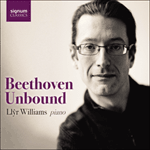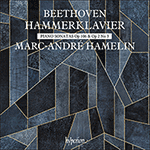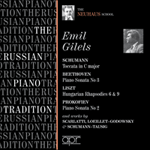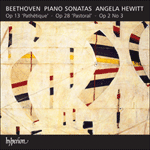
Welcome to Hyperion Records, a British classical label devoted to presenting high-quality recordings of music of all styles and from all periods from the twelfth century to the twenty-first.
Hyperion offers both CDs, and downloads in a number of formats. The site is also available in several languages.
Please use the dropdown buttons to set your preferred options, or use the checkbox to accept the defaults.



The third of the group is the longest and most powerful of the three, although it would scarcely stand comparison with the ‘Hammerklavier’. The first movement is in sonata form, but it owes something to the concerto genre, with an unusual cadenza-like passage near the end, before a final statement of the main theme. The second movement is in E major—this is the first of several C major works by Beethoven that use E as a subsidiary key (others include the ‘Waldstein’ sonata and Leonore Overtures Nos 2 and 3). Its opening theme, however, has a similar melodic outline to that of the first movement and is virtually a transformation of it. The central section of the movement is in E minor, but during the reprise in E major the main theme is suddenly hammered out in C major, as Beethoven cleverly draws attention to its connection to the first movement.
The scherzo is full of light-hearted humour, and the opening four-note figure is used almost obsessively during much of the main section. This figure actually has the same melodic outline as the first four notes of the previous movement (moving stepwise down–up–up), though in a different key and rhythm. A subsidiary ‘trio’ is in A minor, and the reprise of the scherzo is followed by a short coda. The finale is a blend of sonata-form and rondo elements, and its opening four notes (after the initial upbeat) create yet another version of the by-now-familiar stepwise pattern down–up–up. The movement’s unbounded energy is briefly interrupted by a more lyrical theme in F major, but the energy soon returns and builds up to multiple trills in the coda. These lead to a hesitant passage, as if taking a wrong turning, but the home key soon resumes in a final burst of enthusiasm.
from notes by Barry Cooper © 2024
La troisième du groupe est la plus longue et la plus saisissante des trois, même si elle pourrait difficilement soutenir la comparaison avec la «Hammerklavier». Le premier mouvement est en forme sonate, mais il doit quelque chose au genre du concerto, avec un passage inhabituel dans le style d’une cadence vers la fin, avant une exposition finale du thème principal. Le deuxième mouvement est en mi majeur—c’est la première de plusieurs œuvres en ut majeur de Beethoven à utiliser mi majeur comme tonalité secondaire (parmi les autres, il y a notamment la sonate «Waldstein» et les ouvertures Léonore 2 et Léonore 3). Son thème initial présente toutefois un contour mélodique analogue à celui du premier mouvement et en est presque une transformation. La section centrale du mouvement est en mi mineur, mais, au cours de la reprise en mi majeur, le thème principal est soudain martelé en ut majeur, quand Beethoven souligne ingénieusement sa relation avec le premier mouvement.
Le scherzo regorge d’un humour enjoué et la figure initiale de quatre notes est utilisée de manière presque obsédante pendant la majeure partie de la section principale. Cette figure a, en fait, le même profil mélodique que les quatre premières notes du mouvement précédent (descendant–montant–montant successivement), mais dans une tonalité et un rythme différents. Le «trio» subsidiaire est en la mineur, et la reprise du scherzo est suivie d’une courte coda. Le finale est un mélange d’éléments de forme sonate et de rondo, et ses quatre premières notes (après la levée initiale) constituent encore une autre version du schéma descendant–montant–montant maintenant familier. L’énergie illimitée du mouvement est brièvement interrompue par un thème plus lyrique en fa majeur, mais elle revient vite et s’amplifie avec les multiples trilles de la coda. Ces trilles mènent à un passage hésitant, comme si l’on faisait fausse route, mais la tonalité d’origine revient bientôt dans un dernier élan d’enthousiasme.
extrait des notes rédigées par Barry Cooper © 2024
Français: Marie-Stella Pâris
Die dritte Sonate ist die längste und mächtigste der Werkgruppe, obwohl sie sich kaum mit der „Hammerklaviersonate“ vergleichen lässt. Der erste Satz steht in Sonatenform, erinnert jedoch mit einer ungewöhnlichen kadenzartigen Passage gegen Ende, bevor das Hauptthema ein letztes Mal erklingt, auch an die Gattung des Solokonzerts. Der zweite Satz steht in E-Dur—es ist dies das erste von mehreren C-Dur-Werken Beethovens, in denen E-Dur als Nebentonart verwendet wird (zu den anderen gehören die „Waldstein-Sonate“ und die Leonoren-Ouvertüren Nr. 2 und 3). Das Anfangsthema hat jedoch einen ähnlichen melodischen Grundriss wie dasjenige des ersten Satzes und ist praktisch eine Umgestaltung dessen. Der Mittelteil des Satzes steht in e-Moll, doch während der Reprise in E-Dur tritt das Hauptthema plötzlich in C-Dur auf, womit Beethoven geschickt auf die Verbindung zum ersten Satz aufmerksam macht.
Das Scherzo ist unbeschwert und humorvoll, und die einleitende Viertonfigur kommt in fast obsessiver Weise im Hauptteil immer wieder zum Einsatz. Diese Figur hat die gleiche melodische Struktur wie die ersten vier Töne des vorangegangenen Satzes (sie bewegt sich schrittweise abwärts–aufwärts–aufwärts), allerdings in einer anderen Tonart und mit anderem Rhythmus. Ein untergeordnetes „Trio“ steht in a-Moll, und auf die Reprise des Scherzos folgt eine kurze Coda. Das Finale ist eine Mischung aus Sonaten- und Rondo-Elementen, und die ersten vier Töne (nach dem anfänglichen Auftakt) bilden eine weitere Version des inzwischen bekannten schrittweisen Schemas abwärts–aufwärts–aufwärts. Der unbändigen Energie des Satzes wird kurz durch ein lyrisches Thema in F-Dur Einhalt geboten, allerdings kehrt die Eindringlichkeit bald zurück und steigert sich in der Coda zu mehreren Trillern. Diese führen zu einer zögerlichen Passage, als ob eine falsche Abzweigung genommen worden sei, doch ergreift die Grundtonart bald wieder die Zügel und es erklingt ein letzter Ausbruch der Begeisterung.
aus dem Begleittext von Barry Cooper © 2024
Deutsch: Viola Scheffel
 Beethoven: Beethoven Unbound Beethoven: Beethoven UnboundA comprehensive new cycle of the Beethoven sonatas recorded live at London's Wigmore Hall during the pianist's epic fourth rendition of these masterpieces .» More |
 Beethoven: Hammerklavier Beethoven: HammerklavierMarc-André Hamelin brings immense authority (and, it need hardly be added, stunning pianism) to Beethoven’s ‘Hammerklavier’. The resulting account is a thing of wonder, destined to take its place among the great recordings of this monumental work. ...» More |
 Emil Gilels - Schumann, Beethoven, Liszt & Prokofiev Emil Gilels - Schumann, Beethoven, Liszt & Prokofiev |
 Beethoven: Piano Sonatas Opp 2/3, 13 & 28 Beethoven: Piano Sonatas Opp 2/3, 13 & 28 |

